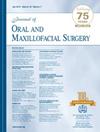眶骨折位置、视力障碍和头部损伤是否与严重眼周损伤相关?回顾性队列研究。
IF 2.3
3区 医学
Q2 DENTISTRY, ORAL SURGERY & MEDICINE
引用次数: 0
摘要
背景:颅颌面骨折累及眼眶是常见的,可能与严重的眼周损伤(OPOIs)相关,需要及时处理。目的:本研究的目的是测量眶骨折(of)位置、视觉障碍(VDs)、头部损伤(HI)和OPOI严重程度之间的关系。研究设计、环境和样本:在日内瓦大学医院进行了一项回顾性队列研究(2008-2021)。纳入标准如下:年龄≥18岁的钝性创伤性OF患者,行头部计算机断层扫描,眼科综合评估,随访≥1年。预测变量:预测因子包括OFs(按解剖位置分类),VD(主观/客观视力下降或复视)和HI,定义为(a)意识丧失,(b)格拉斯哥昏迷量表评分,和/或(c)颅内出血。主要结局变量:主要结局为OPOI严重程度。严重的OPOI被定义为需要立即眼科治疗(不延误或在6小时内进行),而非严重的OPOI不需要立即干预。协变量:协变量包括人口统计学和损伤相关参数。分析:进行描述性、双变量和多变量多项逻辑回归分析,以确定与pois相关的因素。P≤0.05有统计学意义。结果:研究纳入824例患者(平均年龄:47.2±23.6岁),其中男性居多(n = 580;70.4%)。校正分析显示严重的OPOIs与眶内壁骨折相关(优势比[OR], 3.54;95% ci, 1.78-7.07;结论和相关性:在本研究的局限性内,内侧OFs、VD、HI和老年似乎与严重的OPOIs有关。这些发现可能有助于指导OFs患者的早期风险评估和管理。本文章由计算机程序翻译,如有差异,请以英文原文为准。
Are Orbital Fracture Location, Visual Disturbances, and Head Injury Associated With Severe Ocular and Periocular Injuries? A Retrospective Cohort Study
Background
Cranio-maxillofacial fractures involving the orbits are common and may be associated with severe ocular and periocular injuries (OPOIs) requiring prompt management.
Purpose
The purpose of the study was to measure the association between orbital fracture (OF) location, visual disturbances (VDs), head injury (HI), and OPOI severity.
Study Design, Setting, and Sample
A retrospective cohort study was conducted at the University Hospital of Geneva (2008–2021). Inclusion criteria are as follows: subjects ≥18 years with OF due to blunt trauma, who underwent head computed tomography, comprehensive ophthalmological assessment, and had ≥1-year follow-up. Exclusion criteria: subjects <18 years, prior orbital/ophthalmic surgery, penetrating trauma, prior monocular or nonstereoscopic vision, lack of ophthalmological assessment, insufficient clinical data, or follow-up <1 year.
Predictor Variables
Predictors included OFs (categorized by anatomic location), VD (subjective/objective visual acuity decrease or diplopia), and HI, defined as (a) loss of consciousness, (b) Glasgow Coma Scale score, and/or (c) intracranial hemorrhage.
Main Outcome Variable
The primary outcome was OPOI severity. Severe OPOI was defined as requiring immediate ophthalmic treatment (performed without delay or within 6 hours), while nonsevere OPOI did not require immediate intervention.
Covariates
Covariates included demographic and injury-related parameters.
Analyses
Descriptive, bivariate, and multivariate multinomial logistic regression analyses were performed to identify factors associated with OPOIs. Statistical significance was set at P ≤ .05.
Results
The study included 824 patients (mean age: 47.2 ± 23.6 years), the majority of whom were male (n = 580; 70.4%). Adjusted analysis showed severe OPOIs were associated with medial orbital wall fractures (odds ratio [OR], 3.54; 95% CI, 1.78-7.07; P < .01); VD (OR, 3.57; 95% CI, 1.92-6.66; P < .01); HI (OR, 1.99; 95% CI, 1.06-3.74; P = .03) and older age (OR: 1.02; 95% CI: 1.01–1.03; P < .01).
Conclusion and Relevance
Within the limitations of the study, it appears that medial OFs, VD, HI, and older age are associated with severe OPOIs. These findings may help guide early risk assessment and management in patients with OFs.
求助全文
通过发布文献求助,成功后即可免费获取论文全文。
去求助
来源期刊

Journal of Oral and Maxillofacial Surgery
医学-牙科与口腔外科
CiteScore
4.00
自引率
5.30%
发文量
0
审稿时长
41 days
期刊介绍:
This monthly journal offers comprehensive coverage of new techniques, important developments and innovative ideas in oral and maxillofacial surgery. Practice-applicable articles help develop the methods used to handle dentoalveolar surgery, facial injuries and deformities, TMJ disorders, oral cancer, jaw reconstruction, anesthesia and analgesia. The journal also includes specifics on new instruments and diagnostic equipment and modern therapeutic drugs and devices. Journal of Oral and Maxillofacial Surgery is recommended for first or priority subscription by the Dental Section of the Medical Library Association.
 求助内容:
求助内容: 应助结果提醒方式:
应助结果提醒方式:


